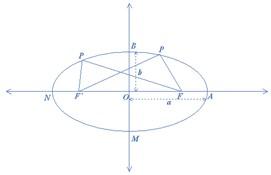An ellipse looks like a regular oval shape, resulting when a cone is cut by an oblique plane in a way that produces a closed curve which does not intersect the base. The ellipse is a closed curve and is symmetric about the centre. In an ellipse, the distance of two points in the interior of an ellipse from a point on the ellipse is same as the distance of any other point on the ellipse from the same point. These points inside the ellipse are termed as foci.
The area of a circle is given by the formula A = π · r2, which is the same as A = π · r · r. If a circle is flattened it will take the form of an ellipse and the semi-axes of such an ellipse (like OA and OB in the figure below) will be the lengthened and shortened radii.
If ‘a’ stands for OA and ‘b’ stands for OB, it can be proved that the area of the ellipse can be found by substituting ‘ab’ for ‘r r’ in the formula for the area of the circle, which then gives the following formula for the area of an ellipse:

A = π · a · b
Where a = semi-major axis or ½ of the major axis.
b = semi-minor axis or ½ the minor axis.
Example 1: If a = 6.0 cm and b = 7.0 cm, find the area of the ellipse.
Solution:
A = π · a · b
A = π · 6.0 · 7.0 = 131.98 cm2
Example 2: Calculate the area of the ellipse where the major radius is 4 cm and minor radius is 3 cm.
Solution:
a = 4; b= 3
Area of the ellipse:
A = π · a · b
A = π · 4 · 3
A = 37.68 cm2
Example 3: Calculate the area of an ellipse whose radiuses are 12.5 ft and 13 ft respectively?
Solution:
Given that: a = 12.5 ft and b = 13 ft
A = π · a · b
A = π · a · b
A = 3.14 × 12.5 ×13
A = 510.25 cm2
Therefore the area of the ellipse= 510.25cm2
Example 4: The ellipse has horizontal radius 8 cm and vertical radius 5 cm. Find the area of ellipse.
Solution:
Given that:
Horizontal radius (a) = 8 cm
Vertical radius (b) = 5 cm
A = π · a · b
A = π · 8 · 5
A = 125.6 cm2
Example 5: The ellipse has horizontal radius 9.5 cm and vertical radius 5.5 cm. Find the area of ellipse.
Solution:
Given that:
Horizontal radius (a) = 9.5 cm
Vertical radius (b) = 5.5 cm
A = π · a · b
A = π · 9.15 · 5.5
A = 164.065 cm2